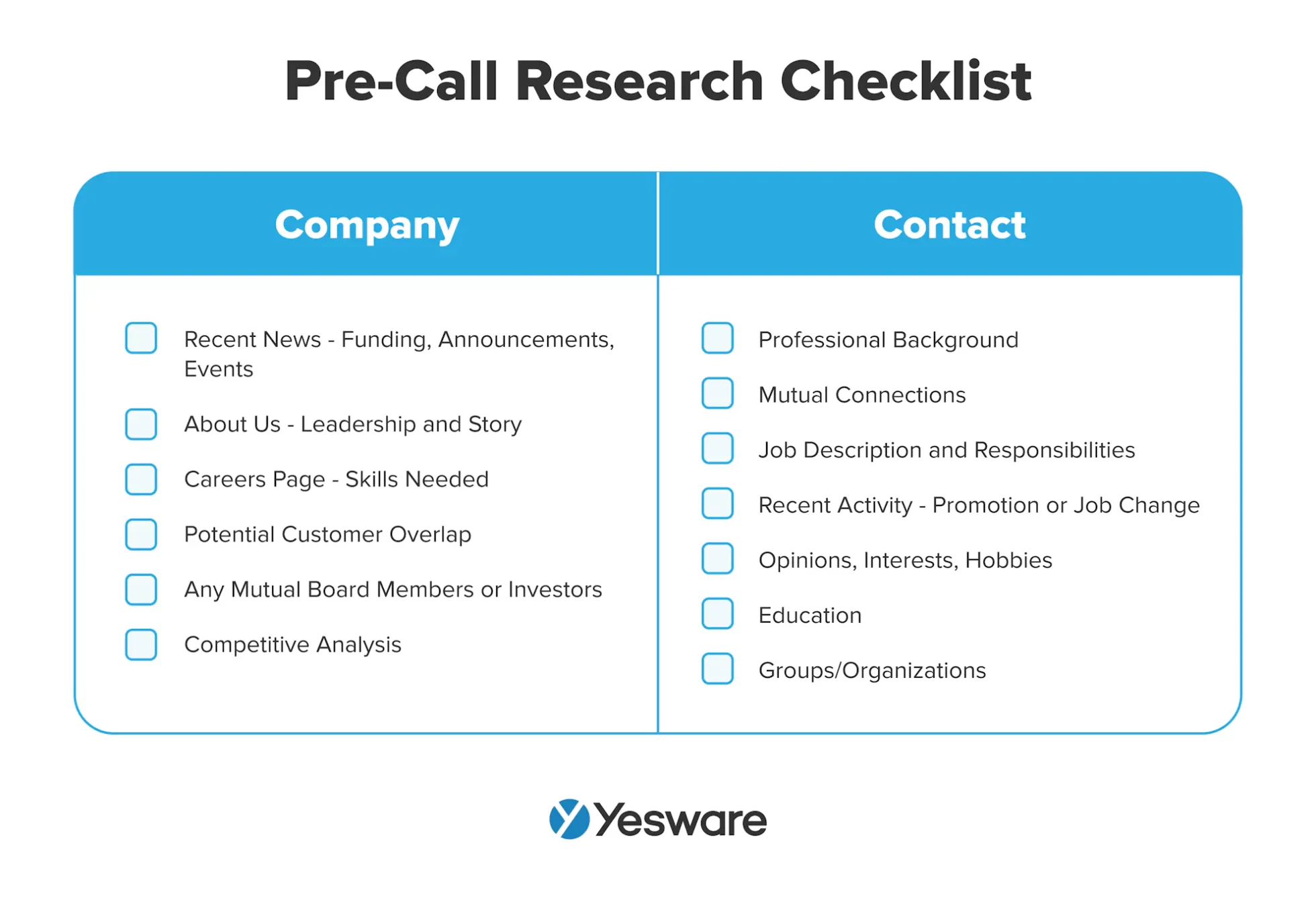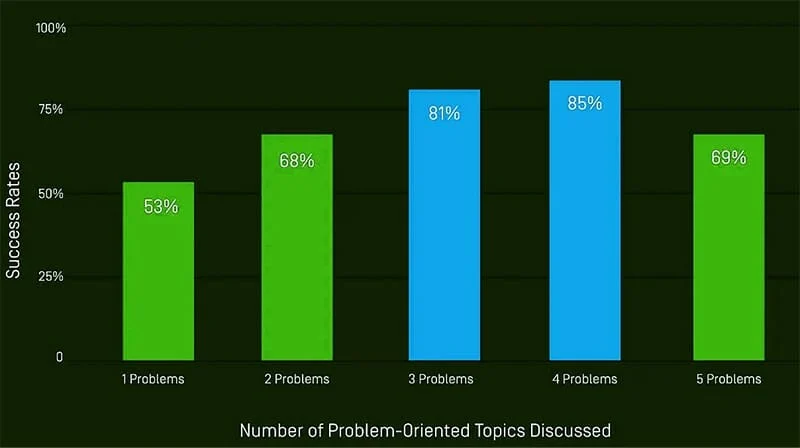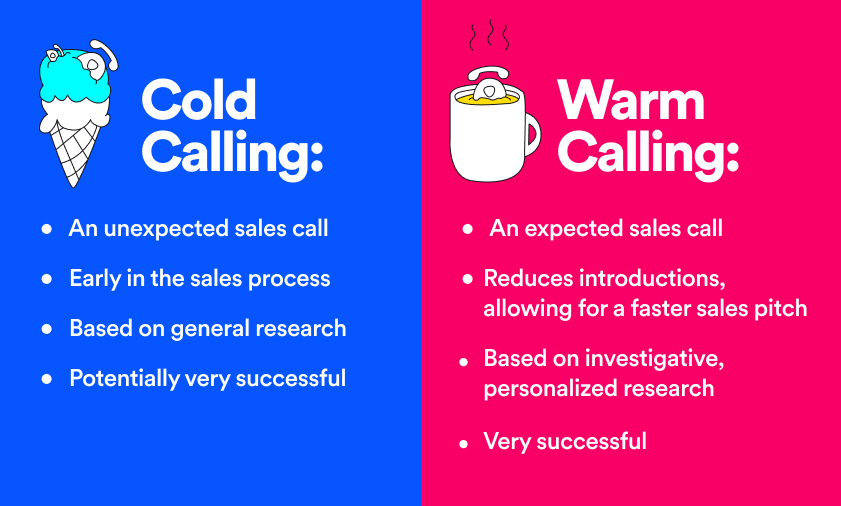There are some cold calling techniques that work so well, they’re just no-brainers to include in your preliminary calls with prospects. Most people who cold call rely on scripted pitches to try and make the sale, but times have changed. People don’t like to be sold to, and unless your sales scripts are spot on, they’re probably more likely to turn people away.
Because of this, an evolution of cold-calling techniques has emerged and there is a particular emphasis on conversing on a personal and deeper level to get the maximum value from each interaction. There are plenty of cold calling tips floating about on the internet, but this article is going to hone in on some specific techniques that you and your sales team can start implementing today to improve conversion rates.
Without further ado, here are 12 of the best cold-calling techniques that will give you the platform to elevate your success.
1. Do Your Research
This should be obvious, but preparation is everything when gearing up to make that first call. You want your team to understand your prospects as much as possible, that means their wants, needs, and the obstacles they need to overcome. This should all take place during the prospecting phase. You want to find the people that are most likely to buy from you, not just any old Joe off the street.
Once you’ve narrowed down your prospects, prioritize them in order of how effective your service will be to adhere to their problems. Scouting LinkedIn will give you the knowledge to help you understand your potential client on a personal and business level. 50% of your prospects will be using it to scout you out after your call, so it’s only fair you do it first. It’s not the most impactful way to research but it’s free and easily accessible.
This also works if you’re directly researching the company, not just the prospect. Gaining key knowledge about the background of the company, related news that’s been released recently, and a high-level overview of what’s what in their company, will give you a competitive edge and brighten your chances of a successful cold call.
Below is a research checklist that can be followed to ensure your team has done the right background checks before making the call.

2. Request Referrals
Requesting a referral is where you contact an existing customer, preferably a content one, and ask for them to refer you to friends, family, and their network as a whole. Referrals can play a significant role in enhancing your cold calling techniques, because you’ll already get a bit of an introduction. Truth be told, it’s slightly warmer than cold. With a referral, you can hop, skip, and jump over the typical sales obstacles, such as the fear of rejection or going straight to voicemail.
Referrals are a great way to generate leads and conversions for your business at a cost-efficient price. They boost your credibility and there will already be a trusting presence between your business and the referral, which takes the pressure away from building that initial rapport.
Ensure you’re asking your referrer when they have no issues and they’re happy with your product. Even better if they’ve made this clear without you prompting them. Clearly map out the benefits of referrals and maybe even throw an incentive their way to sweeten the deal.
It’s down to you to start the conversation. 91% of customers say they’d give referrals, which is the most effective tool salespeople have for cold calling. However, only 11% of salespeople ask for them during cold calls. Don’t be a part of the 89% missing out.
3. Ask Open-Ended Questions
Engage your prospect with thought-provoking questions that get them talking more and create a deeper conversation. If your team is not capturing the full focus of the prospect’s attention during the call, then it’s likely the conversation will not lead to a conversion.
Using this particular cold calling technique will allow your prospect to indulge on a deeper level, encouraging them to be more active during the call. This allows you to gather insights that would not be accessible with a generic sales script.
According to Gong, you should aim to discuss 3-4 problems with your prospect during the cold call. This is the sweet spot in terms of the length of the call and finding the right foothold to springboard into the solution: your product.

4. Open With a Power Statement
Don’t waste any time and just get straight to the point. Use a concise statement that immediately addresses a common and recurring obstacle your prospect faces, and display how your product will provide the solution. The statement needs to be brief yet impactful. Use power words and address the prospect’s concern whilst highlighting the value your product provides.
An example statement is as follows:
“Hi (Prospect’s Name), I have dealt with several companies within your industry that have struggled repeatedly with (Specific Pain Point). The solution we provide has benefited tons of businesses like yours to overcome this issue by (Description Of Solution). I’d love to discuss further how we can help you achieve similar results!”
This opening statement can be even better if you have a testimonial or two to back it up, but don’t force them down your prospect’s throat too early. Just namedrop brands to get them intrigued.
Of all the cold calling techniques listed here, this one is designed to grab the attention of the prospect immediately. Research shows that sales people only have 5 to 10 minutes to convince prospects via cold calling. You’d better make them count.
5. Social Selling
Incorporating social selling into your cold-calling techniques is imperative in the modern age of selling. Millennials now make a whopping chunk of decision making which is changing the way we communicate.
Using social media platforms and company blogs, your team can forge a more personalized relationship with their clientele. 57% of B2B buyers now use social media to research vendors. Just browsing a company’s TikTok or Instagram can give you a glimpse into the company’s ethos and what it stands for.
Furthermore, if you already have the name of the prospect, using social selling will humanize the interaction, in turn building a rapport and hopefully establishing trust. A personal approach does not have to be business-related either; if you know the person on the other end of the line is a HUGE Lakers fan, well hey presto, there’s your starting block.
6. Mirror and Match
As mentioned earlier, nailing the first 30 seconds of a cold call is paramount. If you start strong, you’re more likely to end the call successfully. Bryan Casella, the #1 Real Estate Educator in LA, has a great cold calling technique for you to start implementing in your calls straight away. Check out what he has to say below.
Casella has a vast history as a sales representative and has tons of experience in the sales industry. He emphasizes the importance of mirroring and matching your prospects by literally copying “their tone, their pace, [and] their volume as much as possible. That breeds an air of familiarity and takes them farther away from, ‘This is a cold caller,’ to ‘Maybe I know this person.’”
The initial impression that your team gives off is critical to your success. If your team gives off a bad vibe straight away, it will set the tone for the rest of the conversation. By mirroring the prospect, you capture their tone and you slot into the same wavelength as them. You’re matching their frequency and that automatically makes them feel more comfortable.
It’s such a simple trick yet it works so well!
7. Don’t Sh*t Talk Your Competitors
Your team can summarize the advantages your product has and how it compares to your competitors, but that doesn’t mean you have to talk crap about them.
Speaking poorly of your competitor never makes you look like the good guy. Even if your product blows theirs out the water, it’s important to speak respectfully of them and be humble. In fact, speaking ill of your competitors often has the opposite effect. Prospects don’t want to sit there and listen to you bash your opponents. They want value and a solution to their problem. Remember: you’re the one on the phone to them, not your competitor.
An overview of your competitor’s strengths and weaknesses is a great way of providing value to your prospect during a cold call. You’re providing information at no extra cost and you’re not shoving your product down their throat, but comparing the pros and cons transparently.
Research has indicated up to 65% of B2B companies take the time and care to establish value propositions. Focusing on the unique value of your own product rather than directly disparaging competitors tends to be more effective in landing the sale.
In short, don’t waste time sh*t talking your competitors. Spend that time wisely by talking about how you can benefit the prospect.
8. Display Empathy
Showcasing empathy during cold calls is the catalyst for establishing rapport and building a genuine connection with the prospect.
“If there is any one secret of success, it lies in the ability to get the other person’s point of view and see things from his angle as well as your own."
Henry Ford, Founder of Ford Motor Company Tweet
Demonstrate genuine concern and understanding in regards to your prospect’s problems and trust will naturally follow. A generic cold call with a typical sales spiel will do nothing to help you stand out from the crowd. In fact, it will bury you in it.
To show you truly understand what the prospect is going through, share similar experiences that reveal your understanding of the prospect’s situation. You can also recite what they’ve said back to them in your own words to make them feel heard.
By reflecting and repeating their concerns, you validate them and hopefully establish the foundations of a long-lasting relationship. Furthermore, using empathetic language and altering your tone of voice are both cold calling techniques to display empathy. A lot of sales skills have empathy at their core.
9. Learn Before You Pitch
You and your team don’t need to go all guns blazing into every call by unloading tons of information about your product. Instead of charging in with your sales pitch, use your cold call to learn about the prospect: their goals, needs, and pain points.
In your follow-up call, when you have a better understanding of your prospect, you can tailor your pitch effectively to interact with the prospect better.
Questions to ask to receive this kind of information are as follows:
- Can you share your previous experience with a similar product/s?
- How did they attempt to solve your current issue/s?
- What are your primary objectives?
- Are there any specific outcomes you already have in mind?
- Do you have particular criteria you’re measuring when searching for a solution?
- Would you be open to exploring potential solutions further in a follow-up discussion?
Now your team has all the information needed to develop a personalized sales pitch for the prospect in question. Always keep in mind that with cold calls, you aren’t trying to get the sale on the phone immediately. Nobody is going to commit to buying something from someone they don’t know within a few minutes. Cold calls are to establish rapport and move the prospect down the sales funnel, closer to the purchasing stage.
Don’t worry about trying to keep track of all the prospect’s answers either. Focus on the conversation. Get a tool like tl;dv to record the meeting and take the notes on your behalf. It will summarize what the prospect said afterwards, or you can leave timestamps throughout and hop back to the important parts quickly and easily. You can even make short clips or reels that you can rewatch before your follow-up, ensuring it’s all fresh in your mind and your prospect feels remembered.
10. Persistence Is Key
“The difference between a successful person and others is not a lack of strength, not a lack of knowledge, but rather a lack in will."
Vince Lombardi, NFL Coach Tweet
Persistence is one of the most overlooked cold calling techniques, because it’s not something that’s immediately visible. Being persistent is key; overcoming initial objections and being consistent will ultimately help you achieve greater success and drive those conversion rates up. It might feel like you’re constantly hitting a brick wall, but each and every time you pick up the phone, you’re one step closer to striking gold.
Sales reps who make several calls increase conversion rates by 70%. your job is to find the balance. You don’t want to pester your prospects, but if they have shown interest, it’s important to persist with your follow-ups as 80% of sales require at least five follow up calls.
This shouldn’t just be about follow-ups either. As a cold calling technique, being persistent is just as important, if not moreso. On average, it takes 8 attempts to even reach the prospect when cold calling. If you gave up after one or two, you’d never even have the conversation. People tend not to answer calls from someone they don’t know, so be persistent. If it’s an executive, chances are they’re more likely to pick a few up.
The moral of the story: being persistent pays off.
11. Warm Calling
What’s better than calling up a prospect randomly who isn’t aware of your incoming call? Well, how about calling a prospect who has already shown interest and is on the search for a solution to their problem, that solution being your company?
Whether that interaction was started by an email you sent out before the call, or perhaps a website tracking tool like Clearbit or one of its alternatives has alerted you to the prospect’s presence on your website, it means the prospect knows who you are. You’re not calling completely cold, you’re targeting prospects who already suspect you might be able to help them.
Cold calling is an interruption, whereas warm calling is more of an invited interaction. Warm calling also has a greater conversion rate of 20% compared to around 2% for cold calls.
The infographic below shows the key differences between cold calling and warm calling.

12. Be Patient
Cold calling should always be an initial conversation that leads to an organized meeting. One of the most vital cold-calling techniques is to not rush in for the kill too soon. You want to set the stage for further discussions first.
“Unfortunately, too many salespeople don't ask for a meeting. They use a cold call to sell instead of trying to proceed to the next step of the sales process. That generally doesn't work even when you get through to a potential prospect."
Stephan Schiffman, America's #1 corporate sales trainer Tweet
The message is clear; a cold call is just an initial touch point. Your primary objective is to secure that follow-up meeting and ultimately move towards closing a sale. Trying to shoot your shot too early is going to startle the prospect and have them running for the hills.
Build anticipation. Let them know how you can solve their problem and ignite desire within them. It’ll start small, with a desire to know more, to have a demo, or a trial, and then it’ll come all at once. Be patient.
Elevate Your Sales Game With These Cold Calling Techniques
Mastering cold calling techniques is by no means easy, but it’s pivotal for success in converting those leads into customers. By focusing on building rapport, being genuine, and offering significant value during your cold calls, your team will enhance their chances of success in sales.
Don’t forget though, timing is also important. Figure out the best time to cold call and apply your favorite cold calling techniques at the most opportune moments. Good luck!





